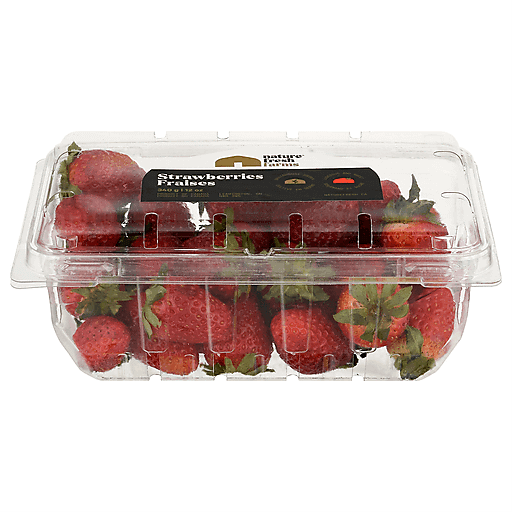One Simple Way to Protect Your Immune System!
Are you aware that eating foods “in season” is a simple way to protect your immune system? According to Stephanie Brown, nutrition educator, dieticians recommend this way of eating for several reasons.
Eating seasonally means filling your plate with fruits and vegetables that were recently harvested in your region. This practice comes with many health, economic, and environmental benefits.

Take strawberries, for instance. If you buy strawberries in the winter, they’re more likely imported from Mexico, Central America, or South America. Since they have to travel a long distance, they’re harvested well before they have reached their peak.
When fruits and vegetables have to travel long distances, factors like temperature and the number of storage days can lead to browning and a loss of vitamins and minerals. And be aware, post-harvest treatments such as heat, edible coating, and ripening agents are applied to fresh produce to ensure it can maintain as much quality as possible.

Besides fresh produce losing nutritional value during transport, there’s also the issue of flavor loss. Anything picked before reaching its peak flavor is always less-than-good.
In contrast, seasonal produce is allowed to stay on the tree, plant, or vine until it is fully ripened and mature. This provides you with more natural flavors and nutrients. The overall quality of the food is simply better on many levels.
Also, eating seasonally means you're adding variety to your diet, which helps reduce cancer risk and promote overall health. The wider the variety of vitamins, minerals, anti-oxidants, trace elements, and colors, the wider the chance your body has to protect itself.

And certain seasonal foods help the body deal with changing weather conditions. Summer produce, like watermelon and cucumbers, will hydrate you when it’s hot, while heartier winter produce, like beets, yams, and squash, are more calorie dense and help your body stay warmer as the temperature drops.
But here’s the thing: Seasonality depends on your local climate. For instance, strawberry season runs from May to June in New Jersey, but it peaks from November to April in Florida.
Regions of our country all have different growing seasons. To get accurate information as to what’s “seasonal” in your area, you can go to your state agriculture department and university extension office. They share seasonal produce calendars online and the U.S. Department of Agriculture (USDA) also has a seasonal produce guide on its website.

In the spring and summer, you can find freshly harvested produce at farm stands, farmers markets, and some grocery stores, or you can go to a local farm that offers pick-your-own produce. The farmers that provide their crops for these venues usually harvest the day before so they’re bringing in the freshest stuff that they have. They’re not bringing anything that’s from last week’s cooler.
And now, many communities have in-door winter farmers markets, making eating local and seasonal food definitely doable.

As a way to get you started, here is the USDA’s general list of seasonal produce that you can use as a guide. I copied it and have it posted on the inside of my pantry door.

I’ll close with a recipe for a seasonal favorite of our family (from www.joyfoodsunshine.com; many thanks to recipe creator, Laura) that uses two winter foods—sweet potatoes and apples. Lastly, here’s to a healthier and truly Happy New Year. Let’s all raise a glass to eating seasonally and as local as possible—one simple way to protect your immune system!
(Oh, and one last thought: Don’t forget to enter this delicious recipe into your Cook’n 15 and then share it with family and friends. I’m convinced you’ll garner a lot of “LIKES” from this one!)

2 medium sweet potatoes (4 cups of 1” cubes)
2 medium apples (about 2 cups of 1” cubes)
3 tablespoons Coconut Oil melted and divided
1 teaspoon sea salt
2 tablespoons pure maple syrup
1 teaspoon ground cinnamon
Directions:
Add Recipe to Cook'n
blog comments powered by Disqus
Eating seasonally means filling your plate with fruits and vegetables that were recently harvested in your region. This practice comes with many health, economic, and environmental benefits.

Take strawberries, for instance. If you buy strawberries in the winter, they’re more likely imported from Mexico, Central America, or South America. Since they have to travel a long distance, they’re harvested well before they have reached their peak.
When fruits and vegetables have to travel long distances, factors like temperature and the number of storage days can lead to browning and a loss of vitamins and minerals. And be aware, post-harvest treatments such as heat, edible coating, and ripening agents are applied to fresh produce to ensure it can maintain as much quality as possible.

Besides fresh produce losing nutritional value during transport, there’s also the issue of flavor loss. Anything picked before reaching its peak flavor is always less-than-good.
In contrast, seasonal produce is allowed to stay on the tree, plant, or vine until it is fully ripened and mature. This provides you with more natural flavors and nutrients. The overall quality of the food is simply better on many levels.
Also, eating seasonally means you're adding variety to your diet, which helps reduce cancer risk and promote overall health. The wider the variety of vitamins, minerals, anti-oxidants, trace elements, and colors, the wider the chance your body has to protect itself.

And certain seasonal foods help the body deal with changing weather conditions. Summer produce, like watermelon and cucumbers, will hydrate you when it’s hot, while heartier winter produce, like beets, yams, and squash, are more calorie dense and help your body stay warmer as the temperature drops.
But here’s the thing: Seasonality depends on your local climate. For instance, strawberry season runs from May to June in New Jersey, but it peaks from November to April in Florida.
Regions of our country all have different growing seasons. To get accurate information as to what’s “seasonal” in your area, you can go to your state agriculture department and university extension office. They share seasonal produce calendars online and the U.S. Department of Agriculture (USDA) also has a seasonal produce guide on its website.

In the spring and summer, you can find freshly harvested produce at farm stands, farmers markets, and some grocery stores, or you can go to a local farm that offers pick-your-own produce. The farmers that provide their crops for these venues usually harvest the day before so they’re bringing in the freshest stuff that they have. They’re not bringing anything that’s from last week’s cooler.
And now, many communities have in-door winter farmers markets, making eating local and seasonal food definitely doable.

As a way to get you started, here is the USDA’s general list of seasonal produce that you can use as a guide. I copied it and have it posted on the inside of my pantry door.

I’ll close with a recipe for a seasonal favorite of our family (from www.joyfoodsunshine.com; many thanks to recipe creator, Laura) that uses two winter foods—sweet potatoes and apples. Lastly, here’s to a healthier and truly Happy New Year. Let’s all raise a glass to eating seasonally and as local as possible—one simple way to protect your immune system!
(Oh, and one last thought: Don’t forget to enter this delicious recipe into your Cook’n 15 and then share it with family and friends. I’m convinced you’ll garner a lot of “LIKES” from this one!)

Cinnamon Rosted Sweet Potatoes and Apples
Ingredients:
2 medium sweet potatoes (4 cups of 1” cubes)
2 medium apples (about 2 cups of 1” cubes)
3 tablespoons Coconut Oil melted and divided
1 teaspoon sea salt
2 tablespoons pure maple syrup
1 teaspoon ground cinnamon
Directions:
1. Preheat oven to 425 degrees F.
2. Grease a large baking pan, set aside.
3. In a large bowl, toss cubed sweet potatoes with 2 TBS of melted coconut oil. Stir until coated.
4. Add sea salt and stir until evenly distributed.
5. Bake in the preheated oven for 20 min, stirring halfway through, until sweet potatoes just barely start to brown.
6. While the sweet potatoes are baking: stir the remaining 1 TBS of coconut oil into the apples. Add maple syrup and cinnamon and stir to combined.
7. After 20 minutes, or the sweet potatoes have begun to brown, remove the sweet potatoes from oven and add the apple mixture and stir to combine.
8. Return to the oven and bake for 20 more minutes, stirring halfway through.
9. Once the sweet potatoes and apples are browned and the maple syrup has caramelized on them remove them from the oven and serve immediately!
2. Grease a large baking pan, set aside.
3. In a large bowl, toss cubed sweet potatoes with 2 TBS of melted coconut oil. Stir until coated.
4. Add sea salt and stir until evenly distributed.
5. Bake in the preheated oven for 20 min, stirring halfway through, until sweet potatoes just barely start to brown.
6. While the sweet potatoes are baking: stir the remaining 1 TBS of coconut oil into the apples. Add maple syrup and cinnamon and stir to combined.
7. After 20 minutes, or the sweet potatoes have begun to brown, remove the sweet potatoes from oven and add the apple mixture and stir to combine.
8. Return to the oven and bake for 20 more minutes, stirring halfway through.
9. Once the sweet potatoes and apples are browned and the maple syrup has caramelized on them remove them from the oven and serve immediately!
Recipe formatted with the Cook'n Recipe Software from DVO Enterprises.
 Alice Osborne
Alice Osborne
Weekly Newsletter Contributor since 2006
Email the author! alice@dvo.com
Sources:
- www.sheltonfarms.com
- www.wwmt.com
- www.foodandnutrtionmagazine.com
- www.meigsindependentpress.com
- www.newsday.com
- www.dinner-mom.com
- www.joyfoodsunshine.com
